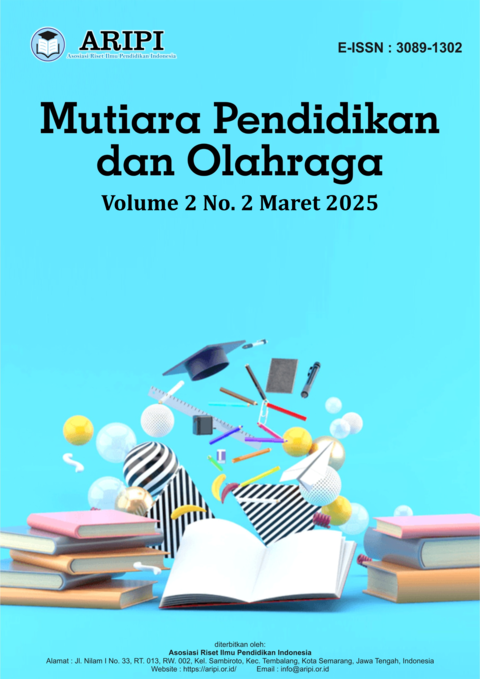Survei Gross Motor Skill Activities Siswa Kelas I SD Negeri 6 Demuk Kecamatan Pucanglaban Kabupaten Tulungagung Tahun 2024
DOI:
https://doi.org/10.61132/mupeno.v2i2.205Keywords:
Lower Grade Students, Gross Motor Skill Activities, ResearchAbstract
This research is to find out a basic picture of the level of development Gross Motor Skill Activities Grade IV students at SDN 6 Demuk, Pucanglaban District, Tulungagung Regency. Because this is another research, this research was carried out on a smaller scale at SDN 6 Demuk, Pucanglaban District, Tulungagung Regency. It is hoped that this research can serve as a guide for other researchers to conduct similar research at the national level. The reason for choosing elementary school students over preschool children is because elementary school students are easier to manage than preschool students. Thus, selecting younger and more beneficial primary school students. Gross Motor Skill Activities (GMSA) is a basic movement pattern to support more complex movements in sports and daily activities. Where elementary school age children, both PAUD, Kindergarten and Elementary School, really enjoy moving, whether playing sports or daily activities. In this research the author used a descriptive quantitative approach and research techniques used survey methods. Where all students will be evaluated with Test of Gross Motor Development-2 (TGMD-2). From a sample of 40 students consisting of 23 male students and 17 female students from 2 classes A and B. The following data was obtained: 23 male students obtained a percentage of 80.38%, 17 female students obtained a percentage of 80.14%, where these results can be categorized as very high for male students and high for female students. So it can be concluded that the level of development Gross Motor Skill Activities class students at SDN 6 Demuk, Pucanglaban District, Tulungagung Regency for the 2023/2024 Academic Year can be said to be high.
References
Activechiropractice.com. (2016, August 3). Selective functional movement assessment. [Website]. https://www.activechiropractice.com
Akdon, & Riduwan. (2007). Rumus dan data dalam aplikasi statistika. Alfabeta.
Arikunto, S. (2010). Prosedur penelitian suatu tindakan praktik. Rineka Cipta.
Bakhtiar, S. (2014). Fundamental motor skill among 6-year-old children in Padang, West Sumatera, Indonesia. Asian Social Science, 10(5), 155-158. https://doi.org/10.5539/ass.v10n5p155
Bernstein, N. A. (1967). The coordination and regulation of movement. Pergamon Press.
Burton, A. W., & Rodgerson, R. W. (2001). New perspectives on the assessment of movement skills and motor abilities. Adapted Physical Activity Quarterly, 18(4), 347–365. https://doi.org/10.1123/apaq.18.4.347
Chek, P. (2014). The seven primal movements.
Cools, W., De, M. K., Samaey, C., & Andries, C. (2011). Fundamental movement skill performance of preschool children in relation to family context. Journal of Sports Sciences, 29(7), 649-660. https://doi.org/10.1080/02640414.2010.551540
Edelman, G. M., & Gally, J. (2001). Degeneracy and complexity in biological systems. Proceedings of the National Academy of Sciences of the United States of America, 98(24), 13763–13768. https://doi.org/10.1073/pnas.231499798
Fisher, A., Reilly, J. J., Kelly, L. A., Montgomery, C., Williamson, A., Paton, J. Y., & Grant, S. (2005). Fundamental movement skills and habitual physical activity in young children. Medicine and Science in Sports and Exercise, 37(4), 684-688. https://doi.org/10.1249/01.MSS.0000159138.48107.7D
Gentile, A. M. (1987). Skill acquisition: Action, movement, and the neuromotor processes. In J. H. Carr, R. B. Shepard, A. M. Gentile, & J. M. Hind (Eds.), Movement science: Foundations for physical therapy in rehabilitation (pp. 93–154). Aspen.
Goodway, J. D., Robinson, L. E., & Crowe, H. (2010). Gender differences in fundamental motor skill development in disadvantaged preschoolers from two geographical regions. Research Quarterly for Exercise and Sport, 81(1), 17-24. https://doi.org/10.1080/02701367.2010.10599624
Guthrie, E. R. (1935). The psychology of learning. Harper & Row.
Hands, B., McIntyre, F., & Parker, H. (2018). The general motor ability hypothesis: An old idea revisited. Perceptual and Motor Skills, 125(2), 213–233. https://doi.org/10.1177/0031512517751750
Hardy, L. L., King, L., Farrell, L., Macniven, R., & Howlett, S. (2010). Fundamental movement skills among Australian preschool children. Journal of Science and Medicine in Sport, 13(5), 503-508. https://doi.org/10.1016/j.jsams.2009.05.010
Haywood, K. M., & Getchell, N. (2020). Life span motor development (7th ed.). Human Kinetics.
Hogan, N., & Sternad, D. (2012). Dynamic primitives of motor behavior. Biological Cybernetics, 106(11–12), 727–739. https://doi.org/10.1007/s00422-012-0527-1
Kiram, Y. (1992). Belajar motorik. Depdikbud.
Knapp, B. (1963). Skill and sport. Routledge and Kegan Paul.
McGinnis, P. M., & Newell, K. M. (1982). Topological dynamics: A framework for describing movement and its constraints. Human Movement Science, 1(4), 289–305. https://doi.org/10.1016/0167-9457(82)90017-3
Newell, K. M. (1978). Some issues on action plans. In G. E. Stelmach (Ed.), Information processing in motor control and learning (pp. 123-144). Academic Press.
Newell, K. M. (2020). What are fundamental motor skills and what is fundamental about them? Journal of Motor Learning and Development, 8, 280-314. https://doi.org/10.1123/jmld.2020-0013
Poulton, E. C. (1957). On prediction in skilled movements. Psychological Bulletin, 54(6), 467–478. https://doi.org/10.1037/h0045515
Seefeldt, V. (1980). Developmental motor patterns: Implications for elementary school physical fitness. In C. H. Nadeau, W. R. Halliwell, K. M. Newell, & G. C. Roberts (Eds.), Psychology of motor behavior and sport (pp. 314–323). Human Kinetics.
Sudijono, A. (2015). Pengantar statistik penelitian pendidikan. Rajawali Press.
Sugiyanto. (2011). Karakteristik anak usia SD. Universitas Negeri Yogyakarta. http://staff.uny.ac.id/sites/default/files/tmp/Karakteristik Siswa SD.pdf
Turvey, M. T. (1990). Coordination. American Psychologist, 45(8), 938–953. https://doi.org/10.1037/0003-066X.45.8.938
Warren, W. H. (2006). The dynamics of perception and action. Psychological Review, 113(2), 358–389. https://doi.org/10.1037/0033-295X.113.2.358
Wickstrom, R. L. (1977). Fundamental movement patterns. Lea & Febiger.
Williams, H. G., Pfeiffer, K. A., O'Neill, J. R., Dowda, M., McIver, K. L., Brown, W. H., & Pate, R. R. (2008). Motor skill performance and physical activity in preschool children. Obesity, 16(6), 1421-1426. https://doi.org/10.1038/oby.2008.214
Wong, K. Y. A., & Cheung, S. Y. (2010). Confirmatory factor analysis of test of gross motor development-2. Journal of Measurement in Physical Education and Exercise Science, 14, 202-209.
Downloads
Published
How to Cite
Issue
Section
License
Copyright (c) 2025 Mutiara Pendidikan dan Olahraga

This work is licensed under a Creative Commons Attribution-ShareAlike 4.0 International License.





